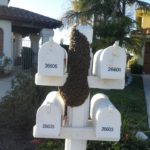FAQ – Frequently Asked Questions
 Our FAQ is designed to help you better know what kind of problem you may have and what to do about it. Consequently, topics covered in this FAQ include bee safety, bee swarms, hive removal and bees. Click on any question below to see the answer. Also, you can also find some safety tips here in case you have some immediate concerns about your safety.
Our FAQ is designed to help you better know what kind of problem you may have and what to do about it. Consequently, topics covered in this FAQ include bee safety, bee swarms, hive removal and bees. Click on any question below to see the answer. Also, you can also find some safety tips here in case you have some immediate concerns about your safety.
If you have further questions or concerns, please contact us by filling out the form on this page.
Bees will build honeycomb in anything that has a void space that makes them feel protected from the perceived threats. As a result, this can include meter boxes, walls, roofs, bbq’s, old furniture, birdhouses, doghouses, wood piles, etc. For an illustration of the areas in which bees love to establish of hive around your home, click here.
We do not recommend you try to deal with this yourself, as you may get stung. Handling bees can be dangerous and requires proper suits and equipment, experience and expertise. Hiring a professional to remove bees makes it safer for people and animals in surrounding areas. We are happy to take care of your bee removal needs!
There is a very good chance they may leave on their own; however, the longer they stay there, the less likely they will leave. A swarm typically leaves on its own within 1 to 3 days. After the third day, the swarm needs to build a home to survive and protect their queen. Once they have built honeycomb, they will not leave on their own and become territorial. Spraying a swarm of bees with water will disrupt the bees and may end up delaying the swarm leaving the area to go to their new home. If you can’t wait for the swarm to leave on their own, always hire a professional to remove them. We try to remove the bees live whenever we can and relocate the swarm.
Not exactly! If bees are consistently entering a gap or opening like a busy airport, they are less likely to leave than if they are out in the open, such as on a tree or a bush. Once bees have settled into a structure, it is highly unlikely for bees to leave on their own. Once a colony has entered a void in your structure, they only need a few days to start setting up shop and building honeycomb. Addressing the situation quickly is much less expensive than waiting and having to open the structure to remove an established colony and its existing honeycomb.
Since bees are attracted to light, bees typically get in the house three ways: through vents, through canned lighting, and through the chimney/fireplace. If bees are entering your home through the fireplace, a temporarily fix includes covering the fireplace with black plastic bags and tape. This measure will only discourage the bees from coming in to see the light inside your home. If they are getting in through vents, turn on any vent fan to discourage them from entering. And if they are getting in through the canned lighting, turn all canned lighting off. Bees indoors are not territorial and typically fly to the window and stay there like a magnet. Simply vacuum them up with a vacuum wand until a technician arrives for service.
Our priority is to remove bees alive. But in many cases, it simply isn’t possible. Some of the reasons we can not remove the bees alive include:
- Type of bee (Africanized vs. honey bee)
- Stage of hive formation
- Access to hive
- Hive age and condition
- Public safety
- Beekeeper availability
Just know, we love bees. We do our best to save as many as possible.
